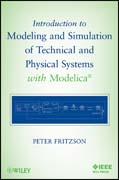
Introduction to modeling and simulation of technical and physical systems with Modelica
Fritzson, Peter
Preface. Acknowledgements. Chapter 1. Basic Concepts. 1.1 Systems and Experiments. 1.2 The Model Concept. 1.3 Simulation. 1.4 Building Models. 1.5 Analyzing Models. 1.6 Kinds of Mathematical Models. 1.7 Using Modeling and Simulation in Product Design. 1.8 Examples of System Models. 1.9 Summary. 1.10 Literature. Chapter 2. A Quick Tour of Modelica. 2.1 Getting Started with Modelica. 2.2 Object-Oriented Mathematical Modeling. 2.3 Classes and Instances. 2.4 Inheritance. 2.5 Generic Classes. 2.6 Equations. 2.7 Acausal Physical Modeling. 2.8 The Modelica Software Component Model. 2.9 Partial Classes. 2.10 Component Library Design and Use. 2.11 Example: Electrical Component Library. 2.12 The SimpleCircuit Model. 2.13 Arrays. 2.14 Algorithmic Constructs. 2.15 Discrete Event and Hybrid Modeling. 2.16 Packages. 2.17 Annotations. 2.18 Naming Conventions.2.19 Modelica Standard Libraries. 2.20 Implementation and Execution of Modelica. 2.21 History. 2.22 Summary. 2.23 Literature. 2.24 Exercises. Chapter 3. Classes and Inheritance. 3.1 Contract Between Class Designer and User. 3.2 A Class Example. 3.3 Variables. 3.4 Behavior as Equations. 3.5 Access Control. 3.6 Simulating the Moon Landing Example. 3.7 Inheritance. 3.8 Summary. 3.9 Literature. Chapter 4. System Modeling Methodology. 4.1 Building System Models. 4.2 Modeling a Tank System. 4.3 Top-Down Modeling if a DC-Motor from Predefined Components. 4.4 Designing InterfacesConnector Classes. 4.5 Summary. 4.6 Literature. Chapter 5. The Modelica Standard Library. 5.1 Summary. 5.2 Literature. Appendix A. Glossary. Appendix B. OpenModelica and OMNotebook Commands. Appendix C. Textual Modeling with OMNotesbook and DrModelica. Appendix D. Graphical Modeling Exercises. Appendix E. Bibliography. Index.
- ISBN: 978-1-1180-1068-6
- Editorial: John Wiley & Sons
- Encuadernacion: Rústica
- Páginas: 224
- Fecha Publicación: 05/08/2011
- Nº Volúmenes: 1
- Idioma: Inglés
